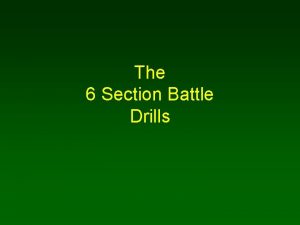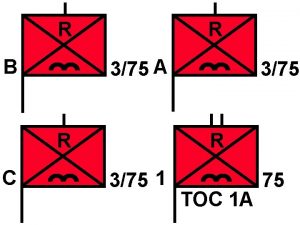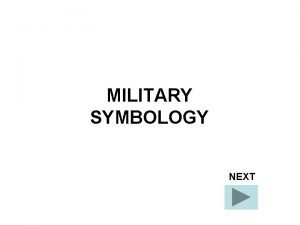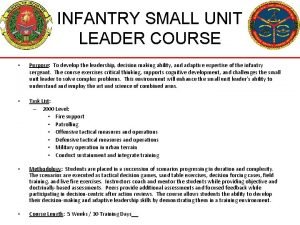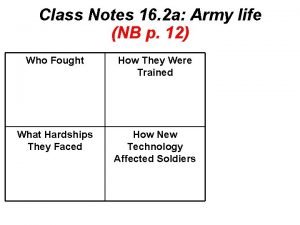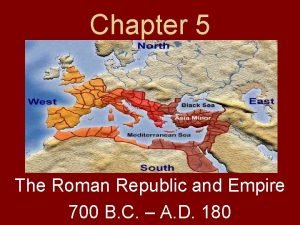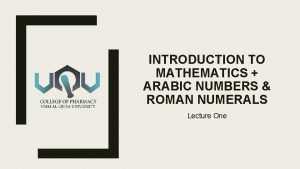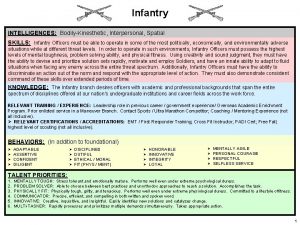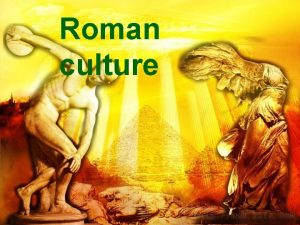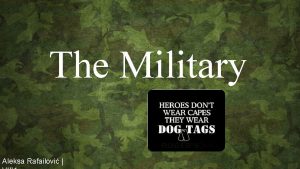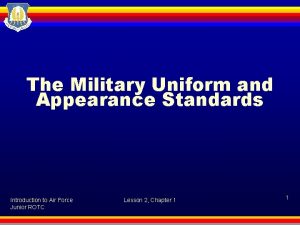Roman Military Introduction Infantry Roman Footsoldiers pedites Uniform





















- Slides: 21

Roman Military Introduction

Infantry: Roman Footsoldiers pedites • Uniform: • issued by a quaestor (elected public office – treasurer, who was assigned to pay soldiers) • cost deducted from salary

Infantry: Roman Footsoldiers pedites • Uniform: • tunica – woolen with short sleeves and extended to knees

Arma vs. Tela • arma refers to defensive armor: lorica, galea, scutum • tela refers to offensive weapons: gladius, pilum http: //trustonailende. wordpress. com/2013/06/02/my-suit-of-armour/

Infantry: Roman Footsoldiers pedites • Uniform: • lorica – coat of leather with protective metal strips across chest, back and shoulders

Infantry: Roman Footsoldiers pedites • Uniform: • caligae – shoes with thick soles, which had nails • tied with leather strips above ankles

Infantry: Roman Footsoldiers pedites • Uniform: • sagum – like a raincoat but also could serve as blanket at night

Infantry: Roman Footsoldiers pedites • Uniform: • galea – helmet made of leather and covered with metal • crista – plume at top of helmet

Infantry: Roman Footsoldiers pedites • Basic Equipment (offense): • pilum – heavy javelin • wooden, but with pointed iron tip • bent after it hit its mark • weighed about 12 lbs. • could be thrown about 70 ft.

Infantry: Roman Footsoldiers pedites • Basic Equipment: • gladius – 2 -edged sword used for handto-hand combat

Standards • signa – signs for regulating movement of legion • aquila – bronze or silver eagle; carried by aquilifer under supervision of primipilus

Standards • signa – standards of maniples were symbolic figures (e. g. , human hand, animals) • carried by signifer

Standards • vexillum – general’s flag (a cloth banner hung from a staff • white banner with general’s name in red letters • red banner over headquarters was signal to arm for battle

Daily Activities • heavy manual labor when not on the march • regular practice of running in full armor • frequent equipment inspections • (building projects like roads during Trajan’s Column showing soldiers peace time) building a fort (#1) and a road (#2)

Soldiers’ March • • about 20 miles/day sarcina – pack/load of material carried by soldier (on his back) • in sarcina: 15 -day food supply; utensils like ax, saw, basket, hook, pans, 2 stakes • soldier toted about 70 lbs. of supplies and weapons

Roman Camp (castra) • • • rectangular surrounded by trench rampart: 5 – 6 ft. high and 6 – 8 ft. wide • interior had a main street with blocks • 4 main gates

Caesar’s Army • consisted of infantry, cavalry, & auxiliaries • divisions of archers (sagitarii) and slingers (auxilia) slingers represented on Trajan’s column

Roman Army: Legio • • legio – averaged 3, 600 legionaries were Roman citizens (17– 50) Divisions in a Legion cohort (360 men) maniple (120 men) century (60 men) maniple = 2 centuries cohort = 3 maniples or 6 centuries legion = 10 cohorts Roman legion ready for combat

Vindolanda • Vindolanda is the site • link to see artifacts of a well preserved and excavations at Roman camp, located Vindolanda: in northern England. • Although Vindolanda http: //www. vindolanda. com/ was settled much later than Caesar’s day, it still offers insight into a soldier’s life.

Dickinson College to the Rescue! http: //dcc. dickinson. edu/ caesar/caesarintroduction • Find vocabulary, textual notes, and other helpful resources at the link to the left.

Let’s Listen and Watch…. De Bello Gallico 1. 1: http: //www. youtube. com/ watch? v=Qcz. Sg. NG 9 b Dc De Bello Gallico 1. 2: http: //www. youtube. com/ watch? v=AW 8 dq. CMj ejo
 Fire team symbols usmc
Fire team symbols usmc 7 section battle drills
7 section battle drills 75 entre 3
75 entre 3 Military symbol for expected enemy
Military symbol for expected enemy Infantry small unit leaders course
Infantry small unit leaders course What's the difference between infantry and cavalry
What's the difference between infantry and cavalry Roman military unit
Roman military unit How do you classify uniform and non-uniform mixtures?
How do you classify uniform and non-uniform mixtures? How do you classify uniform and non-uniform mixtures?
How do you classify uniform and non-uniform mixtures? Teori analisis aliran tak seragam
Teori analisis aliran tak seragam Uniform and non uniform linear motion
Uniform and non uniform linear motion Difference between roman republic and roman empire
Difference between roman republic and roman empire Roman republic vs roman empire
Roman republic vs roman empire 1 to 2000 numbers
1 to 2000 numbers Wren military compass
Wren military compass Military power and control wheel
Military power and control wheel Totalitarianism pros
Totalitarianism pros Taccola's wheel
Taccola's wheel Pirate flag stabbing heart
Pirate flag stabbing heart Great gatsby lesson
Great gatsby lesson The crusades were military expeditions undertaken by
The crusades were military expeditions undertaken by 9 line ied
9 line ied

